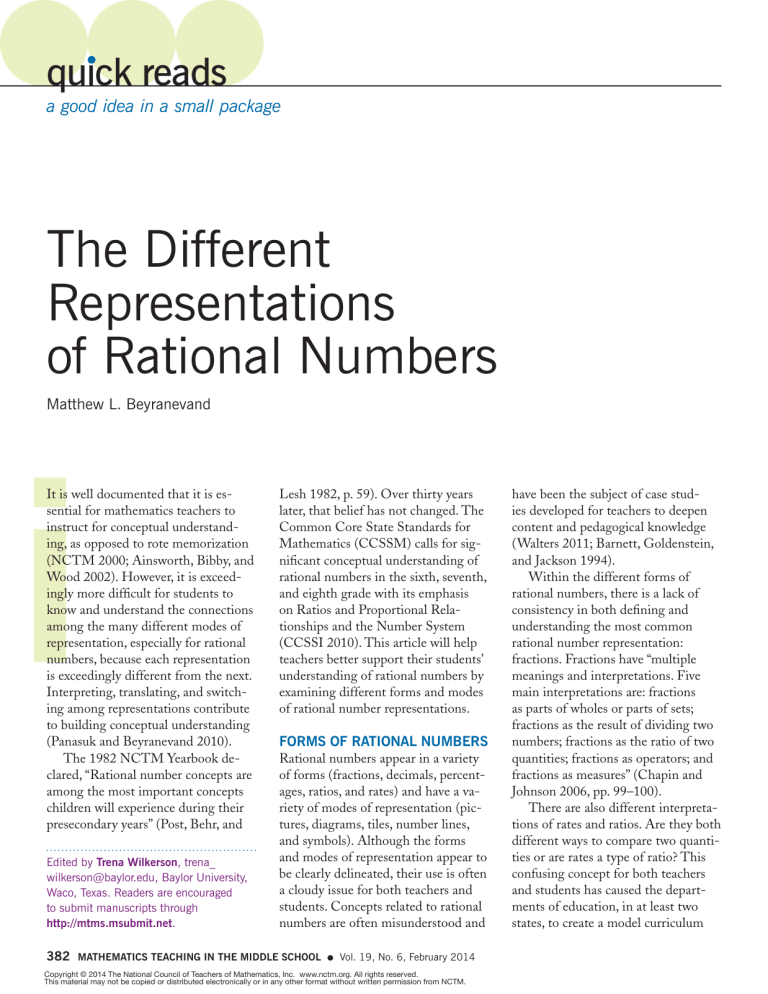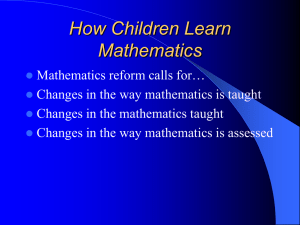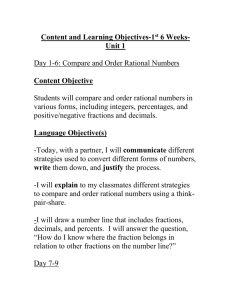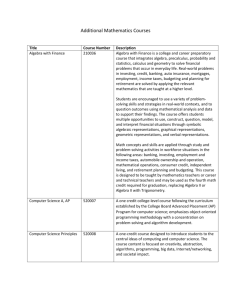
quick reads
a good idea in a small package
The Different
Representations
of Rational Numbers
Matthew L. Beyranevand
i
It is well documented that it is essential for mathematics teachers to
instruct for conceptual understanding, as opposed to rote memorization
(NCTM 2000; Ainsworth, Bibby, and
Wood 2002). However, it is exceedingly more difficult for students to
know and understand the connections
among the many different modes of
representation, especially for rational
numbers, because each representation
is exceedingly different from the next.
Interpreting, translating, and switching among representations contribute
to building conceptual understanding
(Panasuk and Beyranevand 2010).
The 1982 NCTM Yearbook declared, “Rational number concepts are
among the most important concepts
children will experience during their
presecondary years” (Post, Behr, and
Edited by Trena Wilkerson, trena_
wilkerson@baylor.edu, Baylor University,
Waco, Texas. Readers are encouraged
to submit manuscripts through
http://mtms.msubmit.net.
382
Lesh 1982, p. 59). Over thirty years
later, that belief has not changed. The
Common Core State Standards for
Mathematics (CCSSM) calls for significant conceptual understanding of
rational numbers in the sixth, seventh,
and eighth grade with its emphasis
on Ratios and Proportional Relationships and the Number System
(CCSSI 2010). This article will help
teachers better support their students’
understanding of rational numbers by
examining different forms and modes
of rational number representations.
FORMS OF RATIONAL NUMBERS
Rational numbers appear in a variety
of forms (fractions, decimals, percentages, ratios, and rates) and have a variety of modes of representation (pictures, diagrams, tiles, number lines,
and symbols). Although the forms
and modes of representation appear to
be clearly delineated, their use is often
a cloudy issue for both teachers and
students. Concepts related to rational
numbers are often misunderstood and
MATHEMATICS TEACHING IN THE MIDDLE SCHOOL
●
Vol. 19, No. 6, February 2014
Copyright © 2014 The National Council of Teachers of Mathematics, Inc. www.nctm.org. All rights reserved.
This material may not be copied or distributed electronically or in any other format without written permission from NCTM.
have been the subject of case studies developed for teachers to deepen
content and pedagogical knowledge
(Walters 2011; Barnett, Goldenstein,
and Jackson 1994).
Within the different forms of
rational numbers, there is a lack of
consistency in both defining and
understanding the most common
rational number representation:
fractions. Fractions have “multiple
meanings and interpretations. Five
main interpretations are: fractions
as parts of wholes or parts of sets;
fractions as the result of dividing two
numbers; fractions as the ratio of two
quantities; fractions as operators; and
fractions as measures” (Chapin and
Johnson 2006, pp. 99–100).
There are also different interpretations of rates and ratios. Are they both
different ways to compare two quantities or are rates a type of ratio? This
confusing concept for both teachers
and students has caused the departments of education, in at least two
states, to create a model curriculum
unit on Rates and Ratios for sixthgrade mathematics classes (CCGPS
2012; Massachusetts DESE 2012).
One example of a clear and appropriate representation of ratios and
rates is shown in figure 1 (Massachusetts DESE 2012). A few important
misconceptions can be cleared up from
this diagram.
• A rate is a type of ratio. Too often,
these two terms are differentiated.
A rate is really a specific type of ratio in which the units are different.
• It is incorrect to state that a ratio
can always be written as a fraction.
It can only be written as a fraction
if it is a part-to-whole ratio. For
example, if there is 1 girl and
2 boys and one is writing the ratio
of boys to girls, it would erroneously read 1/2 as a fraction. If it
is a fraction, it must represent a
part-to-whole relationship; partto-part ratios cannot be written in
fraction format (Post, Behr, and
Lesh, 1982).
• Although the example of a rate in
figure 1 is a unit rate, it is possible
and common to represent a rate in a
nonunit rate form, such as 5 hotdogs
to 2 people being written as 5 : 2.
MODES OF REPRESENTATION
Rational numbers can be expressed in
various ways, including visual, concrete representations (i.e., diagrams,
pictures, or graphs), verbal representations (written and spoken language),
and symbolic, abstract representations
(numbers, letters). There are unlimited ways to represent rational numbers. Students’ understanding of any
concept is enhanced when exposed
to multiple representations (BoultonLewis and Tait 1993; Outhred
and Sardelich 1997; Swafford and
Langrall 2000). However, students
often have a definitive preference for
using particular representations over
others (Özgün-Koca 1998, 2001;
Fig. 1 This diagram is meant to clarify ratios and rates to avoid misconceptions.
Fig. 2 This student proclaims an unequivocal opinion of this form of representation.
Keller and Hirsch 1998).
Figure 2 illustrates the passion of
a middle school student who dislikes
solving problems represented as a
picture. The student wrote this note
on an exam, unprompted, in response
to a question on linear equations
with one unknown. Although the
Vol. 19, No. 6, February 2014
●
mathematical focus of the example
is not specific to rational numbers, it
illustrates quite well the point related
to students’ dispositions toward use of
specific types of representations.
Previous research (Dreyfus
and Eisenberg 1982; Panasuk and
Beyranevand 2011) has shown that
MATHEMATICS TEACHING IN THE MIDDLE SCHOOL
383
Fig. 3 A number line can help students visualize probability through fractions,
decimals, and percentages.
0/1
0.0
0%
impossible
unlikely
1/2
0.5
50%
equal likelihood
student preference for particular
modes of representation is due in
large part to their achievement level.
Students who are lower achieving on
mathematics standardized tests are
more likely to prefer to use concrete
representations when working with
rational numbers. These students
want to see rational numbers shown
through manipulatives such as counters, rods, pictures, and egg cartons.
Higher-achieving mathematics
students prefer the abstract representations for rational numbers. These
students want to be given the numerical values to manipulate and process.
IMPLICATIONS FOR THE
CLASSROOM
Despite students’ preference to often
work with a singular representation of
rational numbers, it is important for
teachers to continue to use multiple
modes of representation. Moseley (2005) suggested that “an early
exposure to more diverse perspectives
(representations) of rational numbers
assists students in developing more
interconnected and viable representation knowledge for rational numbers”
(p. 37). These diverse representations
should not necessarily be presented
in random order, but rather students
should be introduced to the concrete
representations first and allowed to
slowly transition to the more abstract
modes of representation. Bruner
(1966) proposed to distinguish
three different modes of mental
384
likely
1/1
1.0
100%
certain
representation: the sensory-motor
(physical action upon objects), the
iconic (creating mental images), and
the symbolic (mathematical language
and symbols). Although there is some
disagreement as to this potential
linear transition from one mode to the
next, it is generally beneficial to start
with the concrete.
One way to review the rational
number forms of fractions, decimals,
and percentages is through a probability lesson. Using a number line, as
shown in figure 3, equivalent values
of the different modes of representation can be illustrated, thus helping
students understand the fundamental
properties of probability. In addition,
students are able to make connections
among the many different representations of rational numbers.
The use of multiple means of
representation encourages presenting the “same information through
different sensory modalities” (Bruner
1966, p. 4) and in a format that allows
the student to make adjustments.
Teachers should take the information in the various representations and
teach students how to “transform the
accessible information into useable
knowledge” (Bruner 1966, p. 5). For
rational numbers, this scenario entails
not only understanding each representation but also being able to translate
from one format to another (fractions
to decimals, percentages to fractions,
and so on). Probability examples can
connect the perceived independent
MATHEMATICS TEACHING IN THE MIDDLE SCHOOL
●
Vol. 19, No. 6, February 2014
representations of fractions, decimals,
percentages, and likelihood to different
representations of rational numbers.
When applying multiple means of
engagement, teachers are encouraged
to examine their lessons and present
multiple entry points to create interest in the lesson and concept (Rose
and Gravel 2010). When students
are interested and motivated, learning
is more likely to happen. Therefore,
it is critical for teachers to engage
students and support them in making
connections among different modes
of rational numbers. Students should
understand the various representations, but also know how the concepts
relate to the world in which they live.
For rational numbers, examples of text
messaging, data usage, sports statistics,
and space travel have proven successful
for this educator.
VARYING REPRESENTATIONS
It is considered best practice in mathematics to instruct using multiple
representations to meet the representational preference of each student
and also to teach for understanding.
Both practices will help support
students’ ability to understand rational
numbers and the connections among
the different modes of representation. However, despite the need for
instructing using multiple representations, if individual students struggle
to acquire conceptual understanding
of the mathematical topic, it is worth
noting what their preferred mode of
representation might be.
Teachers should start with students’
preferred mode of representation and
then slowly move toward the other
modes. Lower-achieving students
often prefer to learn with manipulatives or other concrete representations,
whereas higher-achieving students prefer more abstract representations such
as numbers and symbols. Regardless
of the mode of representation, always
teach for understanding.
REFERENCES
Ainsworth, Shaaron, Peter Bibby, and
David Wood. 2002. “Examining the
Effects of Different Multiple Representational Systems in Learning
Primary Mathematics.” The Journal
of the Learning Sciences 11 (1): 2561. doi:http://dx.doi.org/10.1207/
S15327809JLS1101_2
Barnett, Carne, Donna Goldenstein, and
Babette Jackson, eds. 1994. Mathematics
Teaching Cases: Fractions, Decimals, Ratios,
and Percents: Hard to Teach and Hard to
Learn? Portsmouth, NH: Heinemann.
Boulton-Lewis, Gillian, and Kathleen
Tait. 1993. “Young Children’s Representations and Strategies for Addition.” In Contexts in Mathematics Education: Proceedings of the 16th Annual
Conference of the Mathematics Education
Research Group of Australasia, edited
by Bill Atweh, Clive Kanes, Marjorie
Carss, and George Booker, pp. 129–34.
Brisbane: MERGA.
Bruner, Jerome. 1966. Toward a Theory of
Instruction. Cambridge, MA: Belknap
Press of Harvard University Press.
CCGPS Frameworks Student Edition.
2012. 6th Grade Unit 2: Rate, Ratio,
Proportional Reasoning Using Equivalent
Fractions. https://www.georgiastandards
.org/Common-Core/Common%20
Core%20Frameworks/CCGPS_
Math_6_6thGrade_Unit2SE.pdf
Chapin, Suzanne H., and Art Johnson. 2006.
Math Matters: Grades K–8: Understanding the Math You Teach. 2nd ed. Sausalito,
CA: Math Solutions Publications.
Common Core State Standards Initiative
(CCSSI). 2010. Common Core
State Standards for Mathematics.
Washington, DC: National Governors
Association Center for Best Practices
and the Council of Chief State
School Officers. http://www.core
standards.org/assets/CCSSI_Math
%20Standards.pdf
Dreyfus, Tommy, and Theodore Eisenberg. 1982. “Intuitive Functional Concepts: A Baseline Study on Intuitions.”
Journal for Research in Mathematics
Education 13 (November): 360−80.
doi:http://dx.doi.org/10.2307/749011
Keller, Brian, and Christian Hirsch. 1998.
“Student Preferences for Representations of Functions.” International Journal
of Mathematical Education in Science
and Technology 29 (1): 1−17. doi:http://
dx.doi.org/10.1080/0020739980290101
Massachusetts Department of Elementary and Secondary Education. 2012.
Model Unit: Ratios and Rates. http://
www.doe.mass.edu/candi/model/units/
Mathg6-RatioRates.pdf
Moseley, Brian. 2005. “Students’ Early
Mathematical Representation Knowledge: The Effects of Emphasizing
Single or Multiple Perspectives of the
Rational Number Domain in Problem
Solving.” Educational Studies in Mathematics 60 (1): 37−69. doi:http://dx.doi
.org/10.1007/s10649-005-5031-2
National Council of Teachers of Mathematics. 2000. Principles and Standards
for School Mathematics. Reston: NCTM.
Outhred, Lynne, and Sarah Sardelich.
1997. “Problem Solving in Kindergarten: The Development of Children’s
Representations of Numerical Situations.” In People in Mathematics Education: Proceedings of the 20th Annual
Conference of the Mathematics Education
Research Group of Australasia, 2nd ed.,
edited by Fred Biddulph and Ken
Carr, pp. 376–83. Rotorura: MERGA.
Özgün-Koca, S. Asli. 1998. “Students’ Use
of Representations in Mathematical
Education.” Paper presented at the Annual Meeting of the North American
Chapter of the International Group for
the Psychology of Mathematics Education. (ERIC Document Reproduction
Service No. ED425937).
———. 2001. “Computer-Based Representations in Mathematics Classrooms: The Effects of Multiple Linked
and Semi-Linked Representations on
Students’ Learning of Linear Relationships.” Unpublished PhD diss., The
Ohio State University.
Panasuk, Regina, and Matthew
Beyranevand. 2010. “Algebra Students’
Vol. 19, No. 6, February 2014
●
Ability to Recognize Multiple Representations and Achievement.” International Journal for Mathematics Teaching
and Learning. http://www.cimt.ply
mouth.ac.uk/journal/panasuk.pdf
———. 2011. “Middle School Algebra
Students’ Preferred Representations
When Solving Problems.” The Mathematics Educator 13 (1): 32–52.
Post, Thomas, Merlyn Behr, and Richard Lesh. 1982. “Interpretations of
Rational Number Concepts.” In
Mathematics for the Middle Grades
(5–9), 1982 Yearbook of the National
Council of Teachers of Mathematics
(NCTM), edited by Linda Silvey and
James R. Smart, pp. 59–72. Reston,
VA: NCTM.
Rose, David, and Jenna Gravel. 2010.
“Universal Design for Learning.”
In International Encyclopedia of Education, vol. 8, 3rd ed., edited by Eva
Baker, Penelope Peterson, and Barry
McGaw, pp. 119–24. Oxford: Elsevier.
www.udlcenter.org/sites/udlcenter.org/
files/TechnologyandLearning.pdf
Swafford, Jane, and Cynthia Langrall.
2000. “Grade 6 Students’ Pre-Instructional Use of Equations to Describe
and Represent Problem Situations.”
Journal for Research in Mathematics Education 31 ( January): 89−112.
doi:http://dx.doi.org/10.2307/749821
Walters, Jonathan. 2011. “Understanding
and Teaching Rational Numbers: A
Critical Case Study of Middle School
Professional Development.” PhD
diss., ProQuest, UMI Dissertation
Publishing.
Matthew L. Beyranevand,
beyranevandm@
chelmsford.k12.ma.us, is
the mathematics department coordinator for
the Chelmsford Public Schools in Massachusetts and stars in the television show
Math with Matthew. He is also an adjunct
professor in the mathematics department
at UMASS Lowell and in the education
department at Fitchburg State University.
MATHEMATICS TEACHING IN THE MIDDLE SCHOOL
385







